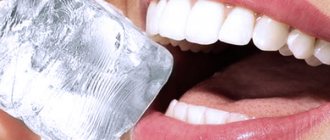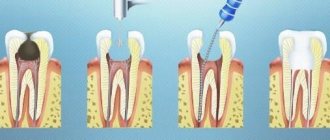If your teeth have a painful reaction to cold or hot food, sweet, sour, toothpaste, or simply to biting and chewing food, then you have hyperesthesia - increased sensitivity of the teeth. According to the World Health Organization, about 60% of the world's population suffers from increased sensitivity of hard dental structures. It manifests itself in the form of mild discomfort or unbearable short-term pain, sometimes becoming sharp and throbbing.
Causes of hyperesthesia
Dental hypersensitivity is caused by many factors and may indicate problems with the teeth and periodontal tissues. Hypersensitivity is one of the most common diseases in dental practice and, according to WHO, is increasing every year.
The mechanisms of the occurrence of pain syndrome due to irritating factors stimulate increased interest among both researchers and practicing dentists, prosthetists, and hygienists. This attention is explained by the fact that pain is a key symptom of most dental diseases. However, the increased susceptibility of hard tissues cannot be justified by the known pathways of nerve signal transmission. This fact prompted a series of studies to be carried out, which resulted in several theories of the development of hyperesthesia:
- odontoblastic;
- receptor;
- threshold;
- hydrodynamic.
Sufficient evidence has been collected in favor of the hydrodynamic theory. It is supported by most dental clinicians. The dentinal tubule, according to theory, is considered as a capillary tube containing fluid inside.
Exposure to air, high temperatures, etc. it shifts, the pressure in the dentin changes. This leads to increased activity of nerve endings. Penetration of irritants into the tubules is possible when dentin, the main hard tissue of the tooth, is exposed. It is exposed not only against the background of carious lesions and diseases of periodontal tissues, but also as a result of non-carious defects: hypoplasia (underdevelopment of teeth), enamel erosion, etc.
Hypersensitivity after tooth filling and preparation for dentures
Most often in dental practice, increased sensitivity is observed after filling. Patients come to the clinic with complaints of sensitivity, especially to cold, without precise localization of pain. Upon visual examination, sensitivity in the basal part is not detected. There is no evidence of open pulp or caries on the x-ray.
The causal unit, however, can be identified. To do this, use ice, which, wrapped in a paper napkin, is applied to the cheek area or to the surface of the tongue. An area with a violation of integrity in hard tissues is a source of irritation, so severe pain occurs in the tooth. Removing all filling material will allow you to detect the break.
The reason for increased susceptibility, often to cold or too hot food, may be the appearance of microgaps between the filling and the hard tissues of the tooth due to compression of the composite material. The gap formed in the cavity near the root canals opens up space for the movement of dentinal fluid, thereby causing a response from the nerve endings of the pulp.
The area of contact of the material with the walls of the internal space of the tooth can also contribute to the formation of hypersensitivity after filling. Since filling composites have a high elasticity index, they cause stress in the contact layer “filling - hard dental tissue”. The tension in the tooth tissues is greater in cases where the surface of the restoration in contact with the walls is extensive.
After preparation (grinding) of a tooth for prosthetic structures and microprostheses, normal sensitivity is observed, which is characterized by mild pain. If there is no inflammatory process in the pulp, the pain is considered causative and disappears a few minutes after the drill stops working. If hypersensitivity persists for a long time (2 or more days after the procedure), treatment of pulpitis is required.
Tooth reacts to sweets after filling
The culprit of a strong reaction to sweets may well be the dentist. If caries is treated, but the pain remains, this may be a sign that:
- the carious cavity was poorly cleaned;
- the filling material was used in insufficient quantities;
- The technology for installing the seal itself is broken.
Temporary hyperesthesia after treatment of caries and any surgical interventions in the oral cavity is a normal option. During the treatment process, the doctor uses both abrasive materials and drugs containing strong acids. And the enamel will take some time to fully recover.
But if month after month passes after treatment, and the sensitivity of the filled tooth does not disappear and even intensifies, it’s time to sound the alarm. This is a clear signal that mistakes were made during the treatment process.
Moreover, sometimes even a dead tooth begins to react to sweets, inside of which there is no living nerve left. Patients are surprised: “Where can pain even come from if the pulp is removed and the canal is sealed?” But the tooth is still surrounded by soft tissues in which the nerve endings are preserved. And they also react sharply to the infectious process.
To identify mistakes made by the dentist when removing the nerve, the doctor may recommend an x-ray examination. It will tell you for sure whether the cause of sensitivity to sweets is a partially preserved pulp, or whether the infection should be looked for in the periodontal tissues.
Provoking factors for the development of dental hypersensitivity
Most often, increased sensitivity is a consequence of a violation of the integrity of the enamel or destruction of the hard tissues of the teeth, which increases the risk of irritation of the endings of the nerve fibers.
The key provocateurs are caries lesions, exposure of the necks and roots of the teeth. Hyperesthesia is diagnosed as a sign of a number of non-carious lesions - enamel defects, progressive loss of enamel and dentin with a decrease in crown height, local destruction, acid necrosis, traumatic injuries, periodontitis with an aggressive course, metabolic disorders of the body, endocrine diseases, mental disorders.
The disease can also occur when consuming large quantities of acidic foods and drinks. Under the influence of acids, the enamel softens and loosens, and erosion appears on its surface.
Increased sensitivity of teeth can be observed after removal of hard dental tissues in order to create a prosthetic space for metal-ceramic structures.
One of the provoking factors is bleaching, during which aggressive chemical bleaching agents are used.
The most common provoking factors also include:
- pulpitis, other dental diseases or pathological conditions that cause destruction of tooth enamel;
- disruptions in the body caused by uncontrolled use of hormonal drugs;
- stress;
- chronic gastrointestinal diseases;
- malocclusion;
- incorrectly selected hygiene products (hard bristled brushes, highly abrasive paste);
- bad habits.
Prevention of tooth reaction to sour foods
The best way to get rid of an unpleasant dental problem is timely prevention, which allows you to prevent the development of factors that provoke increased tooth sensitivity to sour foods.
Prevention of tooth sensitivity to acid is classic and involves a number of measures that significantly reduce the likelihood of hypertension. The best prevention is considered to be:
- Regular oral hygiene - it is recommended to clean the crop using special hygiene products (toothpaste and toothbrush) at least 2 times a day after meals. This approach prevents the accumulation and development of pathogenic microflora in the oral cavity with all the ensuing consequences;
- Timely contact with the dentist - if you have any dental problems: darkening of the enamel, bleeding gums, exposure of the neck of the tooth - contact your dentist immediately. Eliminating the root cause of the problem will help avoid increased tooth sensitivity;
- Correction of the daily diet - if the diet contains a large amount of acidic foods, it is necessary to reduce the amount of them taken. Excessive consumption of acidic foods can lead not only to increased sensitivity or pain in the teeth, but also to a whole range of other problems, including gastrointestinal problems.
To avoid wondering why your teeth hurt after eating something sour, take preventive measures in advance. If this problem occurs to you periodically, consult your dentist. He will collect anamnesis and conduct an examination. It is highly likely that the problem can be prevented without dental treatment.
Diagnostics
When diagnosing dentin hypersensitivity, it should be borne in mind that it is often a symptom of a disease. Therefore, when a patient approaches, the dentist begins treatment with a survey, during which he receives answers to the following questions:
- duration and nature of the pain syndrome;
- number of units with dentin sensitivity;
- localization of increased susceptibility;
- characteristics of stimuli that cause pain.
After the examination, the patient is required to undergo probing of sensitive areas and other diagnostic tests (thermal, electrical, osmotic, evaporative), as well as percussion (tapping on individual areas of the tooth). At the same time, they find out whether the element is sensitive when biting, identify microcracks in the enamel, damage inside and around the filling, malocclusion, and signs of bruxism.
In addition, diagnostics are carried out using hardware methods and “hidden” carious lesions and periapical changes are identified if they are present.
Much attention is paid to determining the level of pain and the degree of tooth sensitivity:
- no pain;
- mild discomfort;
- medium intensity;
- severe pain or unbearable.
The patient's pain reaction may occur to a greater extent to thermal stimuli (cold, heat), tactile (tactile), evaporative (air), electrical or osmotic (solutions of weak acids).
Dentists note that the reaction most often occurs to cold, brushing teeth, heat and sweets.
The more dentin is exposed due to dental diseases and other factors contributing to enamel loss, the higher the degree of hyperesthesia. This is explained by the fact that in completely exposed dentin there are more dilated tubules with open holes.
Initial measures to eliminate signs of hyperesthesia
To eliminate unpleasant sensations, the doctor primarily gives the patient the following recommendations:
- exclude predisposing factors;
- do not consume food acids, that is, refuse those products that contain them;
- Carry out hygienic teeth cleaning long before or after meals;
- Reduce the time you spend brushing your mouth to one minute and use a soft-bristle brush.
The patient's teeth are treated with desensitizers. They reduce the sensitivity of teeth of various etiologies by sealing the dentinal tubules. The use of special toothpastes is prescribed.
When the root and neck of a tooth are exposed, mucogingival surgery (vestibuloplasty, etc.) is used to correct gum recession. During surgery, the soft structures of the oral cavity are moved to those areas that require restoration.
For pulpitis, the doctor resorts to pulpotomy. During a dental operation, the pulp is partially amputated using a vital method. At the same time, that part of it that is located in the root canal remains viable.
If sensitivity to irritants persists, additional diagnostics are carried out to exclude chronic pain syndrome, and a more effective treatment plan is drawn up.
Tooth sensitivity (hyperesthesia)
Encyclopedia of Health / Encyclopedia of Diseases
In general, there is nothing wrong with excessive sensitivity - but only if it is a property of your character, and not of your tooth enamel. If teeth react painfully to cold, sour and sweet foods, this can and should be dealt with.
What exactly hurts?
The pain with hyperesthesia of tooth enamel is short, no longer than 30 seconds, but at the same time stinging and sharp, like the blow of a dagger.
| WHAT IF THIS IS INFLAMMATION? Sensitivity to hot and cold may persist for some time after dental treatment. The reason is mild inflammation of the pulp, which usually goes away after a few weeks. But sometimes such sensitivity signals a serious inflammatory process in the tooth. Here are the signs for which you should definitely consult a doctor :
|
If more than a quarter of all teeth have excessive sensitivity, they speak of generalized hyperesthesia; if less, we are talking about a localized form.
Where does this pain come from? It is not the tooth enamel that is highly sensitive, but the looser layer underneath it, the dentin. Enamel, like strong armor, protects this vulnerable tissue from the aggressive effects of various factors. However, for a variety of reasons, tooth enamel can become thinner and even destroyed, and then the dentin remains defenseless.
However, destruction of tooth enamel alone is not enough for the development of hyperesthesia. Inside the dentin there are thin microtubules through which nerve endings pass. As long as these tubes are closed, the teeth are in relative order (even if there are enamel defects, nothing hurts). But when the dentinal tubules open, exposing the nerve endings, a sharp piercing pain occurs in response to any irritant.
Nature's mistakes and our own
Nervous and endocrine diseases, as well as special hormonal conditions (menopause, pregnancy), in which disturbances of mineral metabolism occur in the body, can make teeth too sensitive. Therefore, it is extremely important to determine your overall health before starting dental treatment. This is the key to not only more effective, but also safer treatment. The fact is that formulations containing fluorides, which are used to combat hyperesthesia, especially in high concentrations, can lead to hypofunction of the thyroid gland if the condition of this organ was not normal. So if you have sensitive teeth and your mouth is full, before visiting the dentist you should also visit an endocrinologist.
Other causes of hypersensitivity often include various dental problems: caries, erosion and cracks of enamel, wedge-shaped defects and bruxism (teeth grinding during sleep). Also, teeth can “become sensitive” if gum atrophy has occurred and their neck is exposed - then the roots of the teeth remain not covered with enamel. This happens due to periodontitis, as well as the characteristics of the bite.
Sometimes we ourselves are to blame for hyperesthesia: for example, if we really like sour foods and carbonated drinks that destroy tooth enamel. The habit of eating very cold and hot foods, as well as improper oral hygiene, also lead to cracks in the enamel. Moreover, the enamel can suffer not only from poor or irregular brushing of teeth, but also from excessive zeal in this matter.
Do not press the brush too hard on your teeth, and do not use brushes with hard bristles or toothpastes that contain a high percentage of abrasiveness.
For prevention
- Pay attention to your diet. The diet must be balanced so that the body does not lack minerals. By the way, one of the causes of hyperesthesia is a deficiency of vitamin A. Therefore, if you have sensitive teeth, it is important to have enough of it (it is found in carrots, eggs, and liver). Avoid carbonated drinks that contain acids - colas, forfeits, sour juices, as well as any acidic foods. After eating (especially if you ate something sweet or sour), you need to brush your teeth or at least rinse your mouth with boiled water;
- Brush your teeth with a soft-bristled brush. Movements should be smooth, vertical, not horizontal. It is better to start not with the incisors, but with the distant teeth.
- Buy pastes with a low degree of abrasiveness (better, special ones for sensitive teeth, for example, Sensodyne, Lakalut, Rembrandt). They may contain potassium salts (nitrate or chloride), fluorides, citrate, strontium. The most common and effective are potassium compounds: they reduce the diameter of the dilated dentinal tubules of sensitive teeth, reduce the flow of fluid inside them and reduce the reaction of teeth to irritants. The effect of using such pastes will be noticeable within a few days. True, after switching to regular paste, everything will return to normal.
- Fluoridated mouth rinses are useful, but they must be prescribed by a doctor, as such products cannot be used regularly.
- Avoid procedures that are risky for sensitive teeth. For example, chemical and mechanical bleaching is contraindicated for you - it is better to resort to ultrasound. This is the most gentle method, in which a low concentration of the active substance is used (5-15% instead of 35-40%), and the exposure time of peroxide on the teeth is minimal - only 12 minutes. There is no heating or injury to dental tissues during the session, so the patient does not experience any unpleasant sensations either before, during, or after the procedure. This method can be used in combination with laser whitening. Before and after the procedure, desensitizing pastes should be used for some time.
Treatment for excess feelingsSUBTLE NATURES Over the past 10 years alone, in Western European countries, the number of visits to the doctor for enamel hyperesthesia has increased by 35%. More than half of the world's population suffers from various forms of tooth sensitivity. Most often women complain about it.
To treat hyperesthesia, dentists use either special varnishes, which close micropores in tooth enamel and empty spaces in dentinal tubules, or remineralizing preparations (usually containing fluoride). Thanks to the latter, the threshold of excitability of nerve fibers increases, and the hard tissues of the teeth are saturated with the missing calcium, phosphorus and magnesium. To make the strengthening substances penetrate the dental tissues more easily, iontophoresis is used (the drugs reach their destination using a weak electric current). So that the patient can continue treatment on his own, there are special mouthguards for home use, which contain desensitizing substances.
Treatment methods for tooth sensitivity
For treatment, medications, combination therapy, complex therapy and physical methods are used.
Algorithm of the doctor’s actions in the treatment of dentin sensitivity:
- decreased excitability of the neuroreceptor apparatus of the dental pulp;
- decreased dentin permeability;
- blocking the entrances and obstructing the lumens of the dentinal tubules;
- mineralization of hard tooth tissue.
Based on the clinical picture, complex therapy may be prescribed, including obturation of the lumens of the dentinal tubules and electrophoresis with sodium fluoride solutions. The entrances of the tubules are closed with resin-containing or salt-containing desensitizers.
Laser therapy, a procedure for reducing pores using remineralizing gels, restoring gums in case of receding gums, filling teeth in places where the protective layer is thinning, and coating the enamel with fluoride varnish can also be used.
At home, the patient is recommended to use pastes containing strontium chloride, potassium nitrate, and sodium citrate for hygienic care.
Medication treatment at home
Dentists consider the use of special gels, rinses, and toothpastes with or without very mild abrasives to be effective treatment at home.
When treating hypersensitivity, potassium nitrate is recognized as the most effective remedy. The therapeutic effect when using hygiene products that contain it occurs as a result of the penetration of potassium ions into the dentinal tubules, where they accumulate, surround the nerves in the pulp areas of the tubules and block their activity, thereby reducing the excitability of the nerve endings.
To achieve the effect, it is recommended to maintain a high concentration of potassium nitrate on the surface of the causative tooth or group of teeth. Potassium nitrate can be used as a solution, gel, paste, or other oral hygiene products.
When using toothpastes containing potassium nitrate or chloride and sodium monofluorophosphate, as when using potassium nitrate alone, hypersensitivity to tactile stimuli and cold air is reduced.
If, after two weeks of daily use in the morning and evening, the therapeutic effect of brushing teeth and applying products containing the substance is not observed, then the patient is recommended to wear mouth guards. They are filled with the same compositions and worn at night. Symptoms of hyperesthesia disappear after two weeks.
Also, positive dynamics in home therapy for hypersensitivity are shown by hygiene products that contain fluorides, strontium salts (chloride or acetate), calcium glycerophosphate or hydroxyapatite.
Please rate this article
Stanislav Mezheritsky
Chief physician, surgeon, orthopedist
The author of the article is Stanislav Mezheritsky, a practicing dentist with 19 years of experience, chief physician and one of the founders of the Matisse Dent clinic. The main focus is orthopedic and surgical dentistry. Author of numerous publications, regular participant in specialized seminars.
What to do if your teeth begin to react to sweets?
If painful sensations arose for the first time, and even after you were carried away by freshly picked raspberries or strawberries, you should not worry too much. Rinse your mouth with clean warm water and try to spare your tooth enamel in the coming days.
But when the situation repeats regularly, there is no point in postponing a visit to the dentist. Perhaps, already at the first appointment, the doctor will detect the problem and draw up a treatment plan. But it is likely that the result of the examination will be a recommendation to consult a periodontist, orthodontist, surgeon, and even a therapist.
Hyperesthesia is one of the most common diseases in the world. Dentists heard complaints about toothache from eating sweets from 37% of their patients. Moreover, the lion's share of them are people of the most productive age: from 20 to 40 years.
Treatment at home
Mild, short-term manifestations of hyperesthesia caused by thinning tooth enamel respond well to home treatment. Moreover, the choice of methods today is very large: from time-tested folk recipes to quick-response pharmacy products.
Traditional methods. Healers recommend relieving acute pain caused by sweet foods with alcohol rinses and a compress in the form of a piece of unsalted lard. To prevent repeated attacks, you should buy purified sea salt at the pharmacy. It should be diluted in the proportion of 1 teaspoon per glass of warm water. And rinse your mouth for 15-20 minutes 3-4 times a day.
A decoction of sage will also help reduce the sensitivity of enamel: 3 tablespoons of dry leaves are poured with a liter of boiling water and boiled for another 10 minutes. Then let it cool and strain. The resulting decoction can simply be periodically applied to the aching tooth, and if the entire dentition is acutely aware of sweets, rinsing will be more effective.
The most unusual folk method that promises to cope with acute toothache caused by sweet foods is acupressure. According to it, you need to press firmly on the nail plate of your index finger for several minutes. Moreover, if the tooth hurts on the right side, you need to press on the finger of your left hand, on the left side - on the right hand.
Hygiene products. In case of severe hyperesthesia, it is worth trying to strengthen the tooth enamel as much as possible. Toothpastes and rinses with fluoride ions will be good helpers in this matter:
- "Lakalut";
- "Sensodyne";
- "Splat";
- "Mexidol dent."
In order not to read into the composition of the product, look for the inscription that the toothpaste is intended for the care of sensitive teeth. Such hygiene products create a protective film on the enamel surface and promote the active absorption of fluoride.
The effectiveness of treatment can be assessed after 2 weeks. If after 14 days of using specialized pastes or rinses there is no effect, the protective layer of enamel is severely damaged. And you can’t do this without the help of a doctor.
Pharmacy drugs. Ideally, they should be recommended by the attending physician. But since the medicines are freely available and do not require special skills to use, thousands of patients use them every day at their own peril and risk.
- “Fluorovarnish”, which forms a dense film on the teeth, thereby reducing the sensitivity of the enamel to external irritants;
- "Remodent", powder for preparing a solution for applications and rinses;
- "Belagel F", restoring the mineral balance of enamel;
- “Diplen”, a film that is temporarily attached to the teeth and saturates the enamel with fluoride compounds.
Like any medications, pharmaceutical drugs for hyperesthesia have side effects and contraindications. Thus, excessive efforts to saturate tooth enamel with fluoride can even lead to such a terrible disease as endemic fluorosis. Therefore, treatment of hyperesthesia at home must be carried out under the supervision of a doctor.
We treat sensitive teeth for 10% cheaper! Sign up!
Moscow
Treatment in dentistry
If a dental pathology is detected when a patient complains about enamel sensitivity to sweets, then the doctor will first treat it:
- will cure caries. Moreover, even if the patient complains of sensitivity of only one tooth, for the purpose of prevention, all carious lesions must be eliminated, and then professional cleaning must be carried out;
- if pulpitis is suspected, an x-ray will be taken, and then a decision will be made: preserve the pulp, remove it partially or completely;
- for periodontal diseases, medication or physiotherapeutic therapy will be prescribed;
If tooth enamel throughout the entire oral cavity is thinning, the dentist may recommend restorative procedures: fluoridation, remineralization, veneers, or enamel implantation.
In the most difficult cases, iontophoresis is used. This is a procedure in which electrodes with a medicinal solution: calcium gluconate or “Fluocal” are applied to the patient’s teeth. Weak electrical discharges allow macroelements to saturate the enamel with the substances necessary for its restoration.
The choice of treatment method for increased tooth sensitivity to sweets directly depends on the cause of the pathology. Only a doctor can determine it, as well as choose the most effective path to recovery.











